A resident of Westbury, NY, Valerie Varnuska is a nature enthusiast who pursues a wide range of outdoor hobbies. Valerie Varnuska is particularly captivated by the night sky, and her fascination has inspired her to engage regularly in stargazing. Some basic tips can help even novice stargazers get the most out of the experience. Stargazing is best practiced in a wide, open area far from electric lighting. Night skies tend to be clearest in winter, though many constellations are visible year-round. Books and other educational resources can aid the amateur in identifying stars, planets, and other objects in the night sky, while many apps available for smartphone download can now provide similar information on the spot. Stargazing is possible with the naked eye, of course, but specialized equipment can enhance the experience. A high-quality set of binoculars, for example, or a telescope will reveal objects that can’t usually be seen. But beginners are advised to familiarize themselves with what's easily visible before acquiring a telescope.
Don't wanna be here? Send us removal request.
Text
A Brief Overview of Astronomy for Beginners
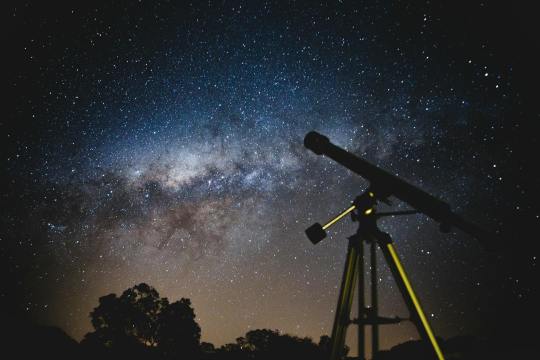
Astronomy, one of the oldest scientific fields, examines the sky and investigates the universe's contents. Professional astronomers study stars and galaxies in greater depth through formal education and research, and beginners can enjoy the field by understanding some basic concepts.
By observing stars and tracking the movements of celestial objects, people gained early knowledge about the cosmos. These observations supported navigation and the development of calendars in early civilizations. Tools like the telescope helped observers identify the physical features of stars and planets, offering information about their formation.
Stars remain central to astronomical studies, including the Sun. Every galaxy contains vast numbers of stars, which together form what astronomers refer to as the large-scale structure of the universe.
Astronomers also focus on the solar system, monitoring the movement of various objects through space. Some of these objects, such as planets, appear to shift their position against the background of stars. Earth is one of these planets and the only one known to support life. Other space objects include asteroids, comets, and meteors. Astronomers also study nebulae - massive clouds of gas and dust in the galaxy that produce new stars.
Astronomy draws from multiple scientific fields to investigate cosmic phenomena. Understanding many astronomy topics often requires knowledge from various disciplines, including biology, chemistry, geology, mathematics, and physics.
0 notes
Text
Qualifications and Training Needed for a Career in Archaeology
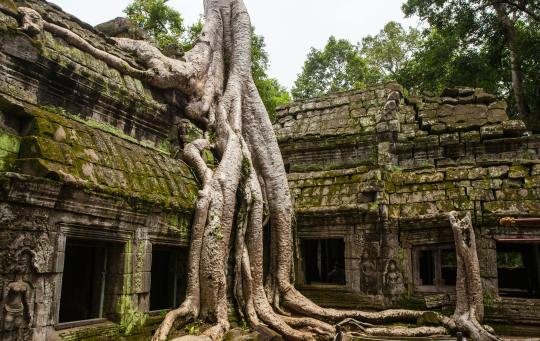
Most salaried roles in archaeology require a degree in archaeology or a related subject such as history. Because competition remains high, many archaeology careers demand strong undergraduate and postgraduate qualifications. Candidates without a relevant undergraduate degree can pursue a postgraduate qualification to gain entrance into the field.
Postgraduate programs offer training in areas like laboratory analysis, reconstruction, and restoration. Knowledge of modern or historical languages, such as Latin or ancient Greek, can also help when interpreting discoveries. A background in historical studies also supports one’s ability to understand archaeological material.
Archeologists need hands-on experience, no matter which areas they choose to explore. Many people volunteer to gain this experience, and some opportunities may require a fee to cover accommodations. Joining a professional archaeological organization in one’s region is another way to stay connected to the field. These organizations may provide grants or funding for research and fieldwork and can give people access to research facilities.
Those who have left school but remain interested in archaeology can join an archaeologist club or local archaeology society to build early experience. It is also a good idea to look out for archaeology apprenticeships that offer structured training and entry-level opportunities.
0 notes
Text
Ocean Fauna in the Hadal Zone

Scientists use a system called the ocean water column to categorize ocean depths by their distance from the surface. The column has five segments: the sunlight zone, the twilight zone, the midnight zone, the abyssal zone, and the hadal zone.
The hadal zone takes its name from Hades, the Greek god of the underworld. This domain ranges from about 19,685 feet below the surface to more than 36,000 feet below and exists only in the world's deepest sea trenches. Sunlight cannot penetrate beyond 3,280 feet below the surface. The hadal zone is one of the darkest natural environments on Earth.
Despite the lack of sunlight, many creatures live in the halal zone. Most animals at these depths are amphipods, flea-like crustaceans in considerable numbers, even at depths of nearly 30,000 feet. Snailfish, the zone's most dominant family, live just under 27,000 feet. They have skeletons made of cartilage instead of bone and skin so translucent that their organs are visible from the outside.
Cusk-eels resemble eels but are more closely related to tuna and seahorses. Cusk-eels are unique among hadal zone creatures because they live in virtually every depth, even the sunlight zone.
0 notes
Text
Tools Archaeologists Use for Excavation and Research

Archaeologists use various tools to locate, document, and analyze artifacts and sites. Their work involves careful excavation, documentation, scientific analysis, and interpretation.
Most archaeologists use a trowel. This tool, resembling a small flat-blade spade, allows archaeologists to remove thin layers of soil with precision. It helps expose buried artifacts while minimizing damage, and its size makes it ideal for delicate excavation work.
Sieves play a key role in recovering small artifacts that might go unnoticed. A sieve is a mesh or screen that archaeologists use to filter excavated soil, separating tiny objects and organic materials from dirt and debris. Sieves vary in size, from large stationary units to portable versions, helping researchers identify and classify artifacts more effectively.
Lastly, a pickaxe helps break through compacted or rocky terrain. With a long handle and a head featuring a pointed and chisel-like end, it loosens hard soil and large stones. While less precise than other tools, the pickaxe allows archaeologists to access deeper layers of a site.
0 notes
Text
The James Webb Space Telescope

The James Webb Space Telescope (JWST), also known simply as Webb, is the largest and most technically advanced space telescope ever built. Notably, it cost $10 billion to develop and build and was designed to be the successor of the Hubble Space Telescope (HST), the first advanced optical telescope launched into Earth's orbit. It can view objects beyond the HST’s capacity.
The National Research Council, a Canadian federal government agency committed to science and technology research and development, identifies the JWST as an important astronomy and astrophysics tool. The JWST is also a key asset for the National Aeronautics and Space Administration (NASA), the nation’s federal agency overseeing the nation's civil space program and aerospace research, as well as the scientific community, playing a pivotal role in the country’s ground and space astrophysics initiatives.
Named after James Webb, NASA’s Apollo program administrator from 1961 to 1968, the JWST is a NASA, European Space Agency (ESA), and Canadian Space Agency (CSA) joint partnership program. NASA’s Goddard Space Flight Center oversaw the telescope's development, while Johns Hopkins University's Space Telescope Science Institute manages its operations. Additionally, Northrop Grumman, an American aerospace and defense company and the JWST project’s primary contractor, led the industry in the telescope’s development.
JWST was launched into space aboard an Arianespace Ariane 5 rocket on December 25th, 2021 from ESA’s rocket launch site at Kourou in France’s overseas department, French Guiana. Ariane 5 is a decommissioned European heavy-lift launch vehicle, previously operated by Arianespace, a French global pioneer in satellite launches, on behalf of the ESA.
The JWST took 30 days to travel about 1 million miles to its ultimate location, a region in space called Lagrange Point 2 (L2), where it arrived on January 24th, 2022. L2 is a point in space near Earth, positioned on the side opposite the Sun. This location enables the telescope to remain aligned with Earth while orbiting the Sun.
The telescope’s mirror is seven times larger than the HST’s, measuring 21.3 feet in diameter. It orbits the sun in a pattern called “Lissajous,” referring to a pattern created when two wavy lines (sinusoidal curves) cross each other at right angles.
Engineers equipped the telescope with 18 gold-plated mirrors that make up its primary mirror. They are gold-plated to protect them from thermal radiation in space. Having 18 separate mirrors results in a massive mirror that couldn’t fit in a rocket. They had to be folded to fit, and were then unfolded once the telescope reached its destination.
The human eye can only observe visible light, which falls in the frequency band known as the optical spectrum. However, the JWST can see a different part of the electromagnetic spectrum called infrared light. Infrared light allows sensors in a device to capture thermal images. The telescope primarily detects infrared light, and since its mirror is so large and there’s no atmosphere in space to obscure visibility, it can view cold, distant, and small objects.
As with the HST, the JWST probes the cosmos to unravel the universe’s history, attempting to understand phenomena like the Big Bang and how exoplanets - planets outside the solar system that orbit stars other than the sun - form. When the telescope was launched, NASA stated that it would focus on four main areas. These include the universe’s first light, the early universe’s galaxies’ assembly, planet formation, including early life origins, and stars’ and protoplanetary systems’ birth.
On July 12th, 2022, the JWST released its first images during a NASA live event. They included the Carina Nebula and the Southern Ring Nebula. The Carina Nebula is a vast gas and dust cloud 8,500 light years away from Earth, where stars constantly form and get destroyed. The Southern Ring Nebula is a large gas cloud around one destroyed star’s atmosphere located about 2,000 light years away from Earth. The telescope continues to take more images, providing deeper insights about the universe.
0 notes
Text
Understanding Solar and Lunar Eclipses

People are fascinated by the concept of an eclipse. An eclipse occurs when the Earth, Moon, and Sun align in a straight line, causing a shadow to be cast, either on the Moon or the Earth. The moon’s orbit around the Earth is tilted relative to the Earth's orbit around the sun. This tilt limits the occurrence of eclipses to a few times a year instead of monthly.
There are two types of eclipses: lunar and solar. A lunar eclipse occurs when the Earth's shadow covers the Moon. During a solar eclipse, the Moon moves between the Earth and the Sun, obscuring the Sun from view.
A lunar eclipse, or eclipse of the moon, occurs at the full moon phase. When the Earth is positioned between the Sun and the Moon, its shadow darkens the Moon's surface. This may result in the Moon appearing red for a period of time. Each lunar eclipse is visible from half of planet Earth.
Lunar eclipses can be categorized as total, partial, or penumbral. A total lunar eclipse happens when the Moon passes completely through the Earth's inner shadow. A partial lunar eclipse occurs when only part of the Moon enters the Earth's shadow, and a penumbral eclipse happens when the Moon passes through the faint outer shadow.
On the other hand, solar eclipses occur during the new moon phase when the Moon comes between the Earth and the Sun, casting a shadow on the Earth and blocking the Sun either partially or completely. Although solar eclipses can occur as frequently as lunar eclipses, they are only visible from a limited area on Earth and are less common.
0 notes
Text
How Deep Sea Fish and Organisms Feed
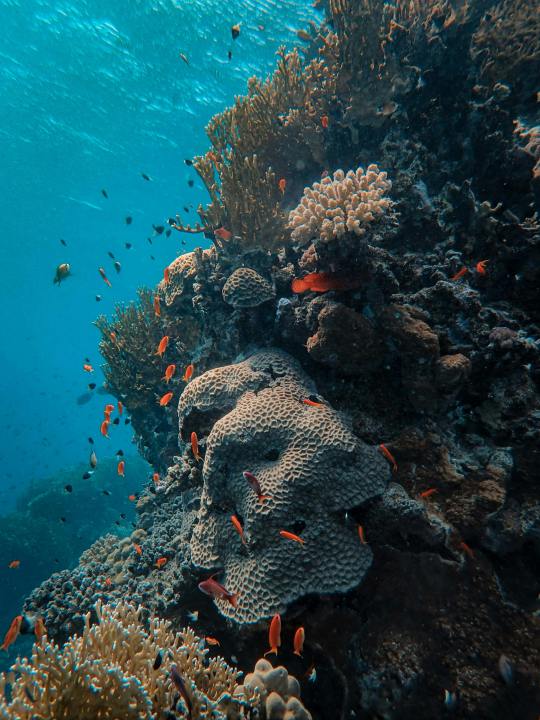
Life in the deep sea environment highly depends on the life in the ocean above. The deep sea is the planet’s largest habitat, with water over 200 meters deep covering around 65 percent of the globe and making up three-quarters of the biosphere. This highly pressurized ecosystem typically pairs low temperatures with the absence of, or substantially reduced, sunlight.
Deep sea spans a diversity of habitats, including abyssal plains, midocean ridges, and trenches. Such habitats are unified in presenting virtually no sources of primary life production. There are a few exceptions, such as specific single-celled archaea and bacteria species that live where water from extremely hot seeps and vents meets frigid ocean water. They are chemoautotrophic. Rather than photosynthesis, they obtain energy from CO2 created by chemical reactions involving oxidation within the local environment.
Beyond these exceptions, deep sea biologic communities are supported by detritus such as fish scales and tiny rotting organisms, which descend from the active layers of the sea above. Filter feeding is a common strategy for deriving nutrition from this “marine snow.” In addition, larger animals such as sharks, orcas, squid, and whales sometimes fall to the seafloor, creating pockets of intense feeding. Several deep-sea-dwelling fish also migrate to surface areas of the ocean at night to feed.
0 notes
Text
The History of Space Exploration

The launch of the first artificial Earth satellite on October 4, 1957, marked the beginning of space exploration. The spacecraft weighed about 83 kg (184 lbs) and had a diameter of 58 cm (23 inches). In a low Earth orbit, it used radio waves to communicate with Earth.
In the early years of space exploration, the missions accomplished several achievements, such as the first animal in space, the first spacecraft to land on the moon, and the first man to orbit Earth. This period also saw the launch of the first successful weather satellite and the first spacecraft to visit another planet.
Mars rovers have followed and orbited every planet in the solar system, bringing back information and pictures. Space rovers have visited Mars, asteroids, and comets. On Mars, the rovers found traces of water. They have also landed on comets.
Dreamers who wrote about space exploration and travel contributed to making it a reality. Several years after the first launch, space agencies and private organizations have expanded the frontiers of space as people hope to achieve more.
0 notes
Text
More Americans Are Enjoying Health Benefits from Time Spent Outdoors

Humans enjoy many physical benefits from spending time in nature. Increased physical activity can help mitigate the symptoms of serious health conditions such as high blood pressure and obesity, while exposure to sunlight can help alleviate vitamin D deficiency. Before the COVID-19 pandemic, Americans spent less time outdoors than ever. A 2018 Outside Magazine study found that nearly half of Americans never engaged in outdoor recreation activities. Only one out of five Americans said they went outside at least once per week.
Participation in outdoor activities increased during the pandemic. Several national parks observed record attendance numbers in 2020. A Pennsylvania State University collaborated with the Leave No Trace Center for Outdoor Ethics on a study that determined half of the country was engaging in outdoor activities at least once per month, and 20 percent described themselves as “new to outdoor recreation.” The pandemic did give some Americans pause, with 13 percent stating they ceased all outdoor recreation activities in response to COVID-19.
While the pandemic may have motivated more Americans to spend time in nature, more recent data suggests this trend has not abated. Outdoor recreation participation increased by 2.3 percent in 2022, up to a record of 168.1 million Americans, or 55 percent of Americans aged six years or older. Outdoor participants engaged in fewer unique activities but became more diverse, including notable increases among Hispanic, Black, and LGBTQIA+ Americans.
0 notes
Text
Two Gemstones That Form in the Earth's Mantle

The Earth’s mantle consists of different materials. While most of the planet’s gemstones can be found in the Earth’s crust, two forms in the mantle: diamonds and peridots. Despite their value, research indicates that diamonds may rank among the most plentiful crystals on the planet. The issue is that the bulk of diamonds cannot be reached due to their location in the mantle.
Diamonds form between 110 and 150 miles below the surface of the Earth. They are surrounded by some of the hottest, most fluid magma on the planet, which allows the magma to explode to the surface through kimberlite pipes, similar to volcanic eruptions. After the pipe cools and the resulting cone erodes, the surrounding area is defined by diamond-bearing rocks. Humans have no feasible methods of accessing diamonds where they form.
Peridot forms much closer to the surface at depths of 20 to 25 miles. For context, humans have only managed to drill about eight miles into the Earth’s mantle, meaning the only reliable method of mining peridot involves locating the site of a volcanic eruption that has eroded enough to expose the underlying gemstones.
0 notes
Text
Tips in Astrophotography

Astrophotography, the art of capturing the beauty of the cosmos through a camera lens, has soared in popularity in recent years. From the mesmerizing glow of distant galaxies to the intricate details of the solar system's planets and moons, astrophotography offers a window into the vastness of the universe. However, mastering this craft requires more than just pointing your camera at the sky and clicking away.
Take some time to plan your shoot. Check weather forecasts, moon phases, and light pollution maps to find the best time and date for astrophotography. Additionally, consider the celestial objects you want to capture and their position in the sky relative to your location. Stability is crucial in astrophotography, as any movement or vibration can result in blurry images. A sturdy tripod keeps the camera steady as you shoot, particularly for long exposures.
While you don't need the most expensive equipment to get started with astrophotography, investing in quality gear can significantly improve your results. A DSLR or mirrorless camera with manual settings, a fast wide-angle lens with a wide aperture (f/2.8 or lower), and a star tracker or equatorial mount are essential for capturing detailed images.
Achieving sharp focus is critical, especially when photographing distant objects like stars and galaxies. Switch your lens to manual focus mode and set it to infinity. You can also use the live view mode on your camera to zoom in on a bright star and manually adjust the focus until it appears sharp.
0 notes
Text
Deep Sea Creatures in the Mariana Trench Region
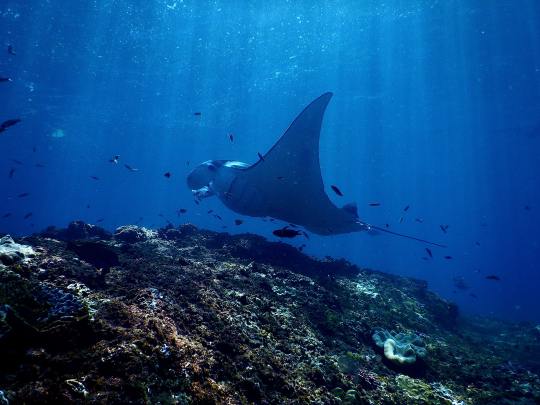
A resident of the Westbury, NY, area, Valerie Varnuska enjoys all art forms, especially dance. In addition to art, Valerie Varnuska has an interest in nature and science, including deep-sea creatures.
The Mariana Trench is home to a host of deep-sea creatures. The trench is part of a network of deep troughs that wind over the ocean floor. The Mariana Trench is in the western Pacific Ocean, east of the Philippines. The trench has a crescent shape and is about 1,500 miles long. Its deepest point is called The Challenger Deep, which is the deepest point in all the world's oceans.
The Mariana Trench is a protected area and home to many deep-sea creatures. Living near the trench, the dumbo octopus has a large head with flappy ears and deep-set eyes. It also has eight stunted tentacles.
The trench is also home to unusual species of fish. The black sea devil has a lower jaw that juts outward. An angler fish, the species has a gaping mouth with razor-sharp teeth. The creature has an antenna-like protrusion that emits light to attract prey.
The frilled shark, another species that lives near the trench, has a long, sleek body similar to an eel. One of the strange features of this shark is that has 300 teeth.
0 notes
Text
Observing the Stars at Night - Stargazing and Astronomy
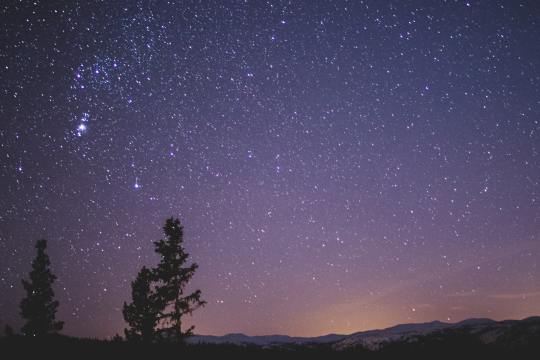
Residing in the Westbury, NY area, Valerie Varnuska enjoys a wide range of personal interests and activities, including art, music, and dancing. Valerie Varnuska is also a nature enthusiast who enjoys stargazing and studying astronomy.
Stargazing can be described as a subset of astronomy since it involves observing the stars at night. However, astronomy extends far beyond the scope of mere stargazing. The invention of telescopes in the 16th century paved the way for the documentation of thousands of celestial bodies.
However, many residents of the United States live where they can't stargaze optimally. City lights, street lights, and other technologies cause light pollution. The best places to observe the skies are dark places devoid of light pollution. This darkness allows light from the stars to reach the naked eye with minimal disturbance.
Fortunately, multiple "dark sky" locations exist in the United States, including Big Bend National Park in South Texas, Great Sand Dunes National Park and Preserve in Colorado, Glacier National Park in Montana, Death Valley National Park in California, and Grand Canyon National Park in Arizona. These parks have campsites where visitors can observe the skies. For the best view, stargazers can use telescopes on clear nights.
0 notes
Text
Archaeologists Discover More Ancient Cities in the Americas and Africa

A resident of the Westbury, NY community, Valerie Varnuska is a lover of nature and archeology. In her free time, Valerie Varnuska enjoys learning about archeological discoveries.
In May 2022, archaeologists uncovered an ancient Mayan city near Merida, Mexico. They discovered the city at a construction site for an industrial park.
The site, Xiol, contains palaces, plazas, and pyramids, many of which feature the Mayan Puuc architectural style. Archaeologists believe over 4,000 people from all social classes lived in the city. They survived on agriculture and fishing, as evidenced by the remains of marine life found near the site. Also found near Xiol were burial grounds where bodies were interred with their belongings, which included obsidian tools.
Xiol is but one of the major city discoveries archaeologists have made recently. In 2021, archaeologists in North Africa found a “Lost Golden City” near Luxor, Egypt. The city, which they believe dates back over 3,000 years, was founded by Pharaoh Amenhotep III. The city contains houses, bakeries, administrative buildings, and several burial sites.
0 notes
Text
What Causes an Aurora? - Astronomical Phenomena
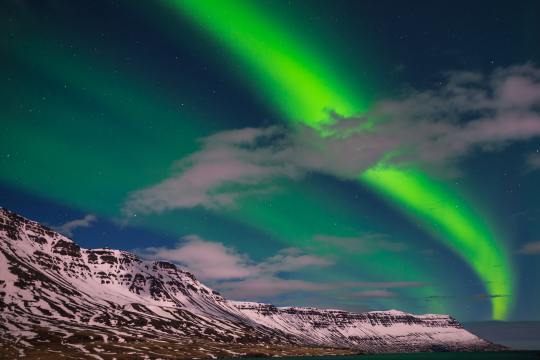
Residing in the area of Westbury, NY, Valerie Varnuska possesses many hobbies and personal interests, including art, music, nature and spending time in the natural environment. Some of Valerie Varnuska’s favorite scientific fields include paleontology and astronomy.
Aurora is a common astronomical phenomenon that manifests in the sky and doesn't require any special telescope or imaging instrument to be noticed. It is characterized by colorful red, blue, yellow, green, and orange lights that mix gently like blowing curtains.
Many viewers describe the experience as a riveting one, and some websites have taken the liberty to provide helpful tips regarding suitable times to visit certain regions to have a chance to observe an aurora. Aurora often appears only in lower polar regions and can be seen almost every night around the Arctic and Antarctic Circles.
Aurora is an indirect consequence of blasts of charged superhot gases that escape from the sun's surface. This stream of charged particles, called the solar wind, is dangerous to live forms when directly contacted. Fortunately, the Earth's magnetic field repels these charged particles and directs them into a seemingly endless journey in space. However, there are some regions where the magnetic field is weak, and some of the ions temporarily penetrate through and get trapped in a part of the earth's atmosphere called the ionosphere.
The ionosphere comprises gaseous nitrogen and oxygen atoms. When these atoms collide with charged particles from the solar wind, energy is released from the impact, resulting in a colorful glowing of the gases.
0 notes
Text
Monterey Bay Aquarium Exhibit Explores the Ocean’s Depths
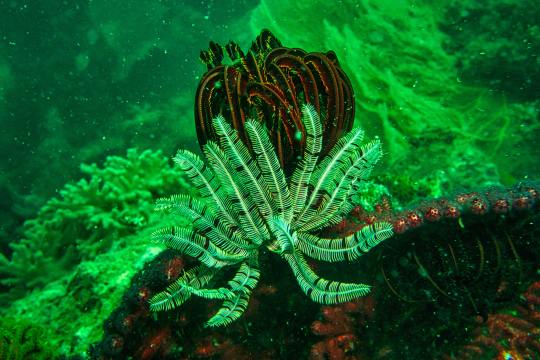
Valerie Varnuska, of the Westbury, NY, community, enjoys exploring scenic natural areas in her free time. Valerie Varnuska has an interest in the marine ecosystem, particularly life that inhabits the furthest depths of the ocean.
In early 2022, the Monterey Bay Aquarium launched the long-term exhibit “Into the Deep: Exploring Our Undiscovered Ocean,” which took five years to bring to reality. Encompassing 10,000 square feet, the exhibit will be in place for eight years. It features unique sea life that was taken from the depths of the local sea canyon by the Monterey Bay Aquarium Research Institute (MBARI).
This was an extremely challenging endeavor, given the lack of visibility in murky depths, as scientists sought to recreate the exact environment in which each specimen was found. For each specimen caught, oxygen level, temperature, and pH level was recorded, so that these conditions could be achieved in the aquarium tank environment.
At the aquarium, visitors walk through dark corridors into rooms that have “ocean floor” and “midwater” themes. The exhibit features everything from invertebrate tunicates that wait for prey anchored on the sea bottom to deep-sea coral. Other species, such as the blood-belly comb jellyfish, are on display for the first time ever in Monterey.
In addition to giving visitors a glimpse of the deep sea’s transfixing biodiversity, the exhibit teaches visitors about the perils presented by plastic in the ocean, even among its bottom dwellers.
0 notes
Text
Unique Temple Discovered in Egypt’s Sinai

A resident of the Westbury, NY, area, Valerie Varnuska has knowledge of natural processes, from the geologic to those occurring in deep space. Valerie Varnuska also has a long-standing interest in archeologic finds, centered on classical antiquity. As reported in Smithsonian magazine, temple sites dedicated to Zeus were until recently thought to be situated only in ancient Greece. However, this idea was challenged in early 2022 with the discovery of a Sinai Desert temple dedicated to Zeus Kasios. This deity combines attributes of Zeus and Mount Kasios, where the sky god waged victorious battle against the monster Typhon, using thunderbolts (thus deciding the cosmos’ ruler). As a geographical location between Turkey and Syria, Mount Kasios experiences numerous thunderstorms, and the locale was a vital worship site among members of various ancient religions. The site around the Zeus-inspired temple had been excavated before, with early-20th-century French archeologists discovering Greek carvings that described Zeus Kasios. With the site left partially excavated, it took a century to discover that there was actually a temple dedicated to Zeus there.
0 notes